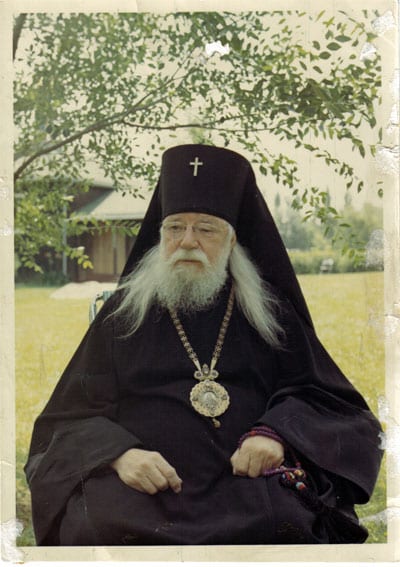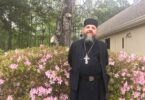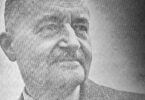Vladika Seraphim, in the world Leonid Georgievich Ivanov, was born in Kursk on 1 Aug 1897, where he attended elementary and secondary school, graduating from the Kursk Classical Gymnasium (High School) in 1915. He then went on to study at Moscow University in the Philosophy Faculty, but his education was interrupted by World War I when the young Leonid joined the Imperial Russian Army. He volunteered for the front with the 1st Siberian Corps, where he took part in the Brusillov Offensive. He was then assigned to the Sergievsky Artillery School in Odessa, and on 15 August 1917 was sent back to the front. After the collapse of the Russian Army, he visited Kursk for a short time for the funeral of his mother in the fall of 1918; she had died in a flu epidemic. He then joined the Volunteer (White) Army, serving in the Markovsky Brigade of the Kornilov Regiment, taking part in the offensives on Kursk and Kharkov. During the retreat of the White Army towards the Crimea, he contracted typhus and spent time in the hospital in Feodosia. Evacuating from Russia with the White Army, he emigrated to Yugoslavia.
In Yugoslavia, the young Leonid continued his education at Belgrade University, where he enrolled in the Philosophy Faculty, but soon switched to the Theology Faculty. “After World War I a great number of Russian emigres arrived in Serbia which was then part of the unified Kingdom of Serbs, Croats and Slovenes (Yugoslavia). Among them also came the university level teaching personnel that included a number of renowned theologians. Together with members of the teaching staff of the Karlovtsy Seminary (Serbian Orthodox Seminary in the town of Karlovtsy-prior to World War I and the creation of the state of Yugoslavia, this seminary was within the borders of the Austro-Hungarian Empire) holding appropriate academic titles, they provided such a teaching body which finally allowed Faculty of Orthodox Theology of the University of Belgrade to start functioning. First meeting of its Council of Professors convened September 6th 1920, and first lectures began December 15th of the same year. Faculty of Orthodox Theology offered a four year course of study and in 1920/21 107 students were enrolled, mostly Serbs.
Following years saw a considerable number of Russians enrolling and, although some variations in number of students occurred, by 1939 Faculty of Orthodox Theology housed some 340 students. Faculty library also opened in 1920, having in its possession 2000 book titles. In 1926 the Faculty started to publish its scholarly periodical called Богословље (Bogoslovlye – Theology), and in 1932 its students initiated their own periodical Светосавље (Svetosavlye – Saint-Sava-ism – i.e. Saint Sava Tradition).” (from www.bfspc.bg.ac.yu the website of the Faculty of Orthodox Theology of the University of Belgrade). After finishing his studies, he served as a teacher of the Law of God in a Serbian High School in Skopje. In 1926, while on summer vacation from his teaching duties, he undertook a pilgrimage to Holy Mount Athos. The previous year, he had heard accounts of the ascetic life of the Russian hermits on the Holy Mountain, and went there to seek guidance from a holy elder in order to decide his future.
He arrived on the Holy Mountain in late June of 1926, and stayed with the Elder Theodossy of Karoulia in order to prepare for monastic tonsure. Elder Theodossy told the young school teacher that if he accepted the monastic tonsure from him, he would have to remain in Karoulia for the rest of his life; the future Vladika Seraphim agreed. Elder Theodossy then sent him to his confessor, the blind Hieroschemamonk Elder Ignaty.
The young Leonid then left with a guide to climb the steep mountain slope to visit Elder Ignaty. The blind Elder twice referred to the young school teacher as a monk; When he explained that he was not a monk, the Elder replied, ‘And I tell you, you are a monk…’ After confessing his entire life to the elder, and telling him that he desired to become a monk and remain forever in Karoulia, the elder said, ‘Let’s pray to God.”
After the elder recited the prayers of absolution, he told the young Leonid, ‘Go back where you came from; you are needed there. Pray to the Great Martyr Panteleimon. You will find an elder in another country.”
Returning to Elder Theodossy and relating what Elder Ignaty had said to him, Elder Theodossy then told him that Elder Ignaty’s insistence on calling him a monk meant that he blessed his intention to be tonsured; his advice to return to Yugoslavia and pray to the Great Martyr Panteleimon meant that he should not be tonsured by Elder Theodossy, but that he would receive the tonsure at the Holy Monastery of Saint Panteleimon. The prediction that he would find an elder in another country meant that the young Leonid would not stay long in Yugoslavia, but would labor in some other country. Years later, Vladika Seraphim remarked: “Everything happened as the elder had foretold to me.” I was tonsured at Saint Panteleimon’s Monastery. I spent two more years in Skopje, and then went to Carpatho-Russia, to Vladimirova, to Archimandrite Vitaly, later Archbishop, in whom I found an elder.”
The young school teacher was tonsured a monk at the Holy Monastery of Saint Panteleimon on Mount Athos on 1 Aug 1926 (according to the Church calendar), the day the Holy Church commemorates the Opening of the Relics of Saint Seraphim of Sarov. At his tonsure, he was given the name Seraphim.
Returning to Skopje, he was ordained to the priesthood by Metropolitan Varnava (Petar Rosic, 1880-1937) of Skopje, later Patriarch of Serbia. The young hieromonk Seraphim served as a parish priest in Skopje until 1928, when he joined the brotherhood of the Monastery of Saint Job of Pochaev in Ladomirova, Czechoslovakia.
In 1931, on Pascha, then Igumen Seraphim went to the Holy Mountain to visit Staretz Silouan (1866-24 Sep 1938; Staretz Silouan was Glorified as a Saint of the Holy Church by the Ecumenical Patriarchate in 1987 as St. Silouan the Athonite). He spoke with the Staretz about interior prayer and other high monastic virtues. He noted that Staretz looked at the person he spoke to with “intelligent, radiant eyes, remarkably deep and true.” Igumen Seraphim was amazed that the Staretz had never studied anywhere, “except the monastery.” He remarked further that his conversation was almost entirely personal in nature, and thus he could not share it. At the time for farewell, Staretz Silouan told Igumen Seraphim that he would pray for his “missionary monastery,” and that he should “never doubt the mercy of God.”
In 1934, the abbot of the Monastery, Archimandrite Vitaly (Vasily Ivanovich Maximenko, 1873-1960), was consecrated to the episcopate for service in America. At that time, Metropolitan Antony (Alexey Pavlovich Khrapovitsky, 1863-1936) elevated the future Vladika Seraphim to Archimandrite and appointed him abbot of the Monastery of Saint Job of Pochaev.
In 1938, at the Second All-Diaspora Sobor of the Russian Orthodox Church Outside of Russia in Belgrade, Archimandrite Seraphim delivered a report ‘On Monasteries and Monasticism,’ which included several recommendations concerning the establishment and activities of Monasteries in the Diaspora.
During the years that Archimandrite Seraphim led the brotherhood of the Monastery of Saint Job of Pochaev, the printing facilities were built up to the point that the Monastery became the most important printing center of the Church Abroad before World War II. In the 1930’s, the Monastery printed fully 75% of all the printed materials produced by the Russian Church Abroad (It is interesting to note that the Holy Monastery of Saint Panteleimon, where Archimandrite Seraphim was tonsuired a monk, was also famous for its puiblicationsDuring World War II, the Monastery played an important role in printing Orthodox literature for distribution in the German occupied areas of the Soviet Union. The brotherhood printed and distributed Altar Gospels, Psalters, Priest’s Service Books, and 200,000 small Gospels in Russian, and apologetical leaflets. The Holy Synod of the Bulgarian Orthodox Church demonstrated its support and appreciation for the missionary printing labors of the brotherhood in the form a donation of one million leva. In October of 1943, Archimandrite Seraphim delivered a report on the brotherhood’s publishing activities to the Council of Bishops of the Russian Church Abroad in Vienna, Austria.
Apart from printing, the Monastery was known for painting Icons in the Old Russian style, making iconostases, and crucifixes. The Monastery’s primary iconographer was Father Kiprian (Pishew, +2001) who also trained many iconographers.
The Monastery also had a broad mission to spread Orthodoxy in Slovakia. While encouraging thousands of pilgrims to visit every year, it never slowed its printing labors. Many pilgrims came to venerate the right hand of Saint John the Forerunner, given to the Monastery by monks of Mount Athos. The results of the missionary work were seen in the increase of the Orthodox population in Slovakia: 2,100 in 1921 and 12,500 in 1940.
From the beginning, the Monastery was under the jurisdiction Mukachevo Diocese of the Serbian Orthodox Church. The Diocesan Charter required that the monks were to be Czech citizens. Archimandrite Seraphim stated that this was impossible, that he had no intention of becoming a Czech citizen, because the Monastery was there, he explained, to prepare themselves for the future of the Church in Russia. On 24 Feb 1939, the Russophile Diocesan Bishop, Vladimir (Rajic), formally recognized the Monastery as within the jurisdiction of the Russian Church Abroad. (Bishop Vladimir {Rajic}, born 1882, studied at Moscow Theological Academy, consecrated Bishop for the Mukachevo Diocese in 1937 by Patriarch Gavrilo (Gavrilo Dozic, +1950) of Serbia, Metropolitan Anastassy (Alexander Alexeyevich Gribanovsky, 1873-1965) of the Russian Church Abroad, and the Serbian Bishops Iriney, Simeon, and the New Martyr Dosifey. After World War II, the area was occupied by the Soviets, and the Diocese was informed that it was then under the jurisdiction of the Moscow Patriarchate).
In 1944, the brotherhood was forced to flee from the Monastery in order to escape the advance of the Red Army into Czechoslovakia. After a stay in Germany, the brotherhood then went to Switzerland. In February of 1946, Archimandrite Seraphim was consecrated to the episcopate as Bishop of Santiago and Chile. The consecration took place in the Cathedral of the Elevation of the Holy Cross in Geneva, and was presided over by Metropolitan Anastassy (Gribanovsky), assisted by Bishop Ieronim (Chernov) of Montreal and Canada (later Archbishop of Detroit and Flint), and Bishop Nafanail (L’vov) of Brussels and Western Europe (later Archbishop of Vienna and Austria). After participating in the Council of Bishops, which met in Munich, Germany in May of 1946, Vladika Seraphim, unable to assume the post in Chile, emigrated with the brotherhood to the United States, where they joined the Holy Trinity Monastery in Jordanville, New York. Vladika Seraphim was named Abbot of the Monastery, and Bishop of Holy Trinity, and was a Vicar of the Diocese of Eastern America. In November of 1946, as an introduction to the turbulent situation of Orthodoxy in America, Vladika Seraphim attended the infamous “Cleveland Sobor,” during which the North American Metropolitan District seceded from the Church Abroad. As a newly arrived Bishop in the United States, Vladika Seraphim attended as a guest observer.
It was on Vladika Seraphim’s initiative that the New Kursk Root Hermitage was founded in Mahopac, New York. The well-known philanthropists, Prince and Princess Belosselsky-Belozersky, learning of the proposed transfer of the Synod of Bishops of the Russian Orthodox Church Outside of Russia and the Kursk-Root Icon of the Mother of God to the US, agreed to donate their country estate near Mahopac. With the blessing of His Eminence Metropolitan Anastassy, a stavropighial Synodal podvorie (branch) was set up on the estate. The founder and rector of this podvorie was Bishop Seraphim (Ivanov). At the beginning of the 1950’s, he arrived at his new appointment alone and without a penny in his pocket. After some time, two hieromonks joined to form a brotherhood, while the Russian engineer V.I. Vishnevsky and his assistants began renovation and construction. Feb 5 1951 became a historic day in the life of the Russian Orthodox Christians in the USA: the Kursk-Root Icon of the Mother of God travelled to America, accompanied by Archimandrite Averky (Alexander Pavlovich Taushev, later Archbishop,1906-1976 ). Bishop Seraphim welcomed the Icon at the airport and it was quickly driven by car to the Kursk-Root Hermitage. Bishop Seraphim stayed at Mahopac until he as transferred to the Chicgao Diocese.
Upon the repose of Archbishop Gregory (Borishkevitch) of the Diocese of Chicago, Detroit and Midwest America in October of 1957, Vladika Seraphim was appointed to head the Diocese. In 1959, he was elevated to Archbishop. In 1960, in a brotherly effort to aid the Greek Old Calendar Church, Archbishop Seraphim and Bishop Teofil (lonescu, 1894-1975), a Romanian hierarch who belonged at that time to the Church Abroad, consecrated Archimandrite Akakios (Pappas) to the episcopate. At that time, the Greek Old Calendar Church was without any hierarchs, and Archimandrite Akakios had been selected as a candidate for the episcopate by a council of 100 Old Calendar priests in Greece. The consecration was not sanctioned by Metropolitan Anastassy and the Synod, but was finally confirmed by Metropolitan Philaret (George Nikolaevich Voznesensky, 1903-1985) and the Synod in the late 1969.
Also in 1960, Vladika Seraphim established the Organization of Russian Orthodox Pathfinders (ORPR), and found land in a rural area 100 miles west of Chicago for the establishment of a children’s summer camp to be operated by the ORPR. The property was named “Vladimirovo,” and today is home not only to the ORPR Summer Camp, but also to Saint Vladimir’s Parish, and a “Russian Village” of retirement and summer homes. The land was purchased for the archdiocese by long-time benefactors of the Russian Church Abroad – Prince Sergei and Svetlana Belosselsky.
Vladika Seraphim had a great love for youth, and for the Summer Camp, he founded. With his kellenik, Archimandrite Feofan (Shishmanov), Vladika Seraphim spent every summer at Vladimirovo, celebrating the Divine Services for the Camp, and instructing the children in the Holy Orthodox Faith. Due to his love for and experience in working with youth, Vladika Seraphim was appointed by the Synod to oversee work with youth for the entire Church Abroad. Vladika Seraphim continued to be active at the ORPR Summer Camp until declining health and old age no longer allowed him to do so.
In 1974, Vladika Seraphim requested that Igumen Alypy (Gamanovich) of Holy Trinity Monastery be consecrated to the episcopate as Bishop of Cleveland, Vicar of the Chicago-Detroit Diocese, in order to help administer the Diocese. The consecration took place in the Holy Virgin Protection Cathedral in Chicago in October of 1974.
When the current First Hierarch of the Russian Orthodox Church Outside of Russia, Metropolitan Hilarion (Kapral, b. 1948), was consecrated to the Episcopate on 27 Nov/10 Dec 1984 in the Synodal Cathedral of the Mother of God of the Sign in New York, Archbishop Seraphim was among the nine Hierarchs performing the consecration. Vladika Seraphim was first in seniority of consecration at that time.
From 1976, Vladika Seraphim was first deputy to Metropolitan Philaret. In the mid 1980’s, Vladika Seraphim returned to live at the New Kursk Root Hermitage in Mahopac, New York with his kellenik, Archimandrite Feofan. Although bodily weak and infirm, Vladika Seraphim retained his mental clarity until the very end. He reposed in the Lord at the New Kursk Root Hermitage in Mahopac in 12/25 Jul 1987, and was buried in the cemetery there. Archimandrite Feofan, who survived him for only a short time, is buried alongside Vladika Seraphim.
Vladika Seraphim authored numerous articles, which appeared in various Church periodicals, and was editor of Pravoslavnaya Rus for several years, beginning in Czechoslovakia and continuing at Jordanville. He also authored several books, among which were Palomichestvo v Svyatuyu Zemlyu (Pilgrimage to the Holy Land), and Odigitria Russkago Zarubezhye (Directress of the Russian Emigration), which is a complete and detailed history of the Holy Kursk Root Icon. Vladika also frequently addressed his flock on the Russian radio program “Zarya.” Two books of Vladika’s radio talks were published in Chicago, in 1968, and in 1972.
- “Sovyeshchanie arkhiereev v Vien’. Pravoslavnaya Rus. Nos. 11-12, 30 October 1943. Monastery of Saint Job of Pochaev. Ladomirova, Czechoslovakia
- Alexeeva, Ludmila. ‘Zhiznenni Put Arkhiepiskopa Serafima’. ORPR: 1960-1985. ORPR Minneapolis Chapter. Minneapolis, Minnesota 1985
- Holy Transfiguration Monastery. A History of the Russian Church Abroad: 1917-1967. Saint Nectarios Press. Seattle, Washington 1972
- (Karambalas), Archimandrite Cherubim. Contemporary Ascetics of Mount Athos, Volume 2. Saint Herman of Alaska Brotherhood Press. Platina, California 1997
- Psarev, Andrei. ‘Zhizneopisanie Arkhiepiskopa Leontiya Chiliskago’. Pravoslavnaya Zhizn. Numbers 555 (Mar.), 556 (Apr.), & 557 (May), 1996. Holy Trinity Monastery. Jordanville, New York
- Seide, Fr. Georg. Geschichte der Russischen Orthodoxen Kirche im Ausland von der Grundung bis in die Gegenwart. Otto Harrassowitz. Wiesbaden, Germany 1983
- Seide, Fr. Georg. Monasteries and Convents of the Russian Orthodox Church Abroad. Translated by Theophilos Lasswell. Monastery of Saint Job of Pochaev. Munich, Germany 1990
- www.rusyn.org
- www.catacomb.org
- www.ortho-rus.ru
- www.orthodoxengland.org
- www.stsergius.org
- www.wikipedia.org
- www.bfspc.bg.ac.yu











